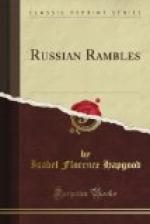“What, have you no kerchief?” they asked, as though I were a peasant or petty merchant’s wife, and could remove the typical piece of gayly colored cloth from my head or neck. When I objected to transporting eggs and berries in my only resource, my handkerchief, they reluctantly produced scraps of dirty newspaper, or of ledgers scrawled over with queer accounts. I soon grew wise, and hoarded up the splint strawberry baskets provided by the male venders, which are put to multifarious uses in Russia.
After being asked for a kerchief in the markets, and a sheet when I went to get my fur cloak from its summer storage at a fashionable city shop, and after making divers notes on journeys, I was obliged to conclude that the ancient merchant fashion in Russia had been to seize the nearest fabric at hand,—the sheet from the bed, the cloth from the table,—and use it as a traveling trunk.
The Finns at the market were not to be mistaken for Russians. Their features were wooden; their expression was far less intelligent than that of the Russians. The women were addicted to wonderful patterns in aprons and silver ornaments, and wore, under a white head kerchief, a stiff glazed white circlet which seemed to wear away their blond hair. These women arrived regularly every morning, before five o’clock, at the shops of the baker and the grocer opposite our windows. The shops opened at that hour, after having kept open until eleven o’clock at night, or later. After refreshing themselves with a roll and a bunch of young onions, of which the green tops appeared to be the most relished, the women made their town toilet by lowering the very much reefed skirt of their single garment, drawing on footless stockings, and donning shoes. At ten o’clock, or even earlier, they came back to fill the sacks of coarse white linen, borne over their shoulders, with necessaries for their households, purchased with the proceeds of their sales, and to reverse their toilet operations, preparatory to the long tramp homeward. I sometimes caught them buying articles which seemed extravagant luxuries, all things considered, such as raisins. One of their specialties was the sale of lilies of the valley, which grow wild in the Russian forests. Their peculiar little trot-trot, and the indescribable semi-tones and quarter-tones in which they cried, “Land-dy-y-y-shee!” were unmistakably Finnish at any distance.
The scene at the market was always entertaining. Tzarskoe is surrounded by market gardens, where vegetables and fruits are raised in highly manured and excessively hilled-up beds. It sends tons of its products to the capital as well as to the local market. Everything was cheap and delicious. Eggs were dear when they reached a cent and a half apiece. Strawberries, huge and luscious, were dear at ten cents a pound, since in warm seasons they cost but five. Another berry, sister to the strawberry, but differing from it utterly in taste, was the klubnika, of which there were two varieties, the white and the bluish-red, both delicious in their peculiar flavor, but less decorative in size and aspect than the strawberry.




